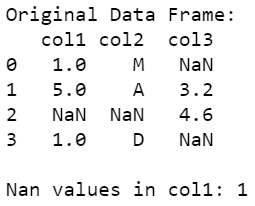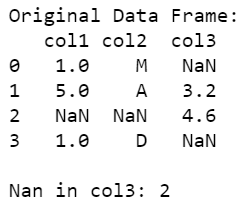How to Count the NaN Occurrences in a Column in Pandas Dataframe?
Last Updated :
11 Dec, 2020
The data frame is divided into cells, which can store a value belonging to some data structure as well as it may contain missing or NA values. The pandas package contains various in-built functions, to check if the value in the cell of a data frame is either NA or not, and also to perform aggregations over these NA values.
Method #1: Using In-built methods isna() and sum() on the dataframe.
The isna() function is used to detect missing/none values and return a boolean array of length equal to the data frame element over which it is applied and the sum() method is used to calculate a total of these missing values.
Python3
import pandas as pd
import numpy as np
data = [[1, "M", np.nan], [5, "A", 3.2], [
np.nan, np.nan, 4.6], [1, "D", np.nan]]
data_frame = pd.DataFrame(data,
columns=["col1", "col2", "col3"])
print("\nOriginal Data Frame:")
print(data_frame)
cnt = data_frame["col1"].isna().sum()
print("\nNan values in col1:", cnt)
|
Output:

Method #2: Using the length of the dataframe
The count of the values contained in any particular column of the data frame is subtracted from the length of dataframe, that is the number of rows in the data frame. The count() method gives us the total number of NaN values in a specified column and the length(dataframe) gives us the length of the data frame, that is the total number of rows in the frame.
Python3
import pandas as pd
import numpy as np
data = [[1, "M", np.nan], [5, "A", 3.2],
[np.nan, np.nan, 4.6], [1, "D", np.nan]]
data_frame = pd.DataFrame(data, columns=["col1", "col2", "col3"])
print("\nOriginal Data Frame:")
print(data_frame)
length = len(data_frame)
count_in_col3 = data_frame['col3'].count()
cnt = length - count_in_col3
print("\nNan in col3:", cnt)
|
Output:

Share your thoughts in the comments
Please Login to comment...